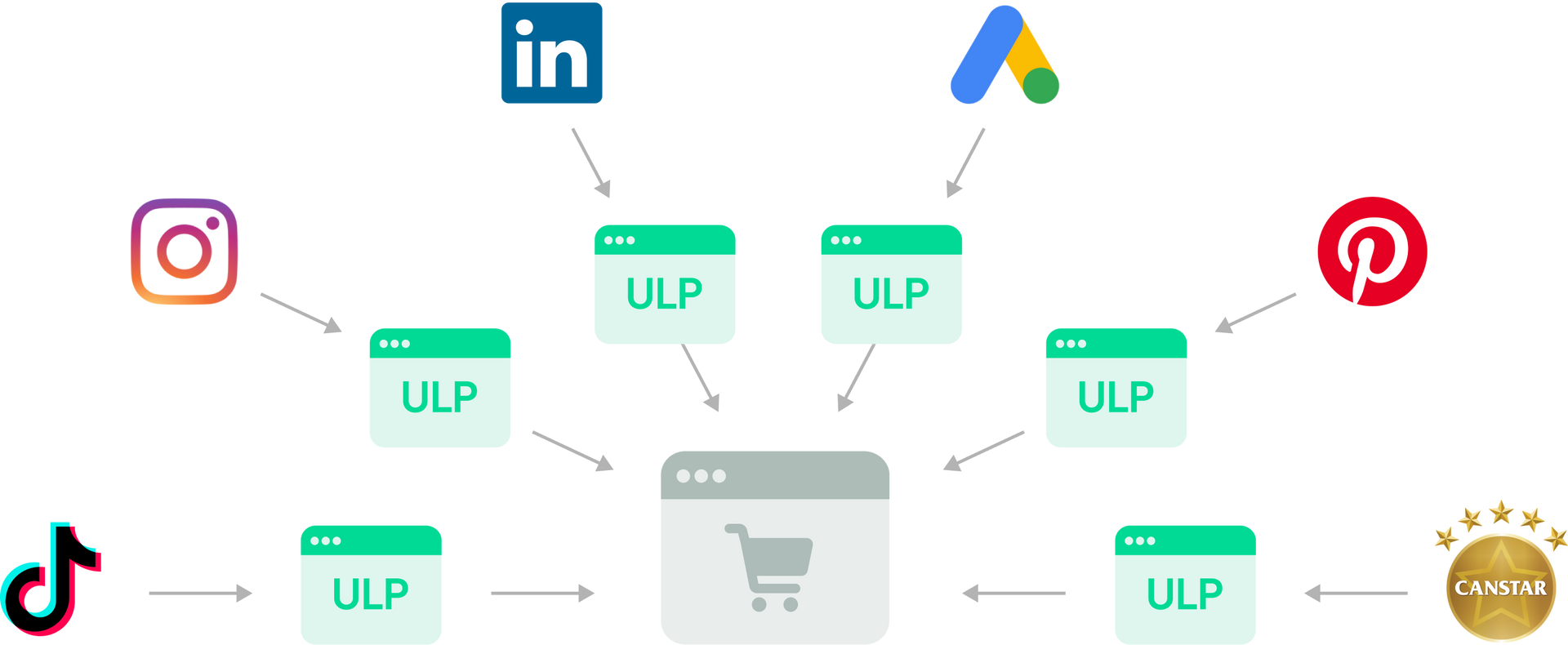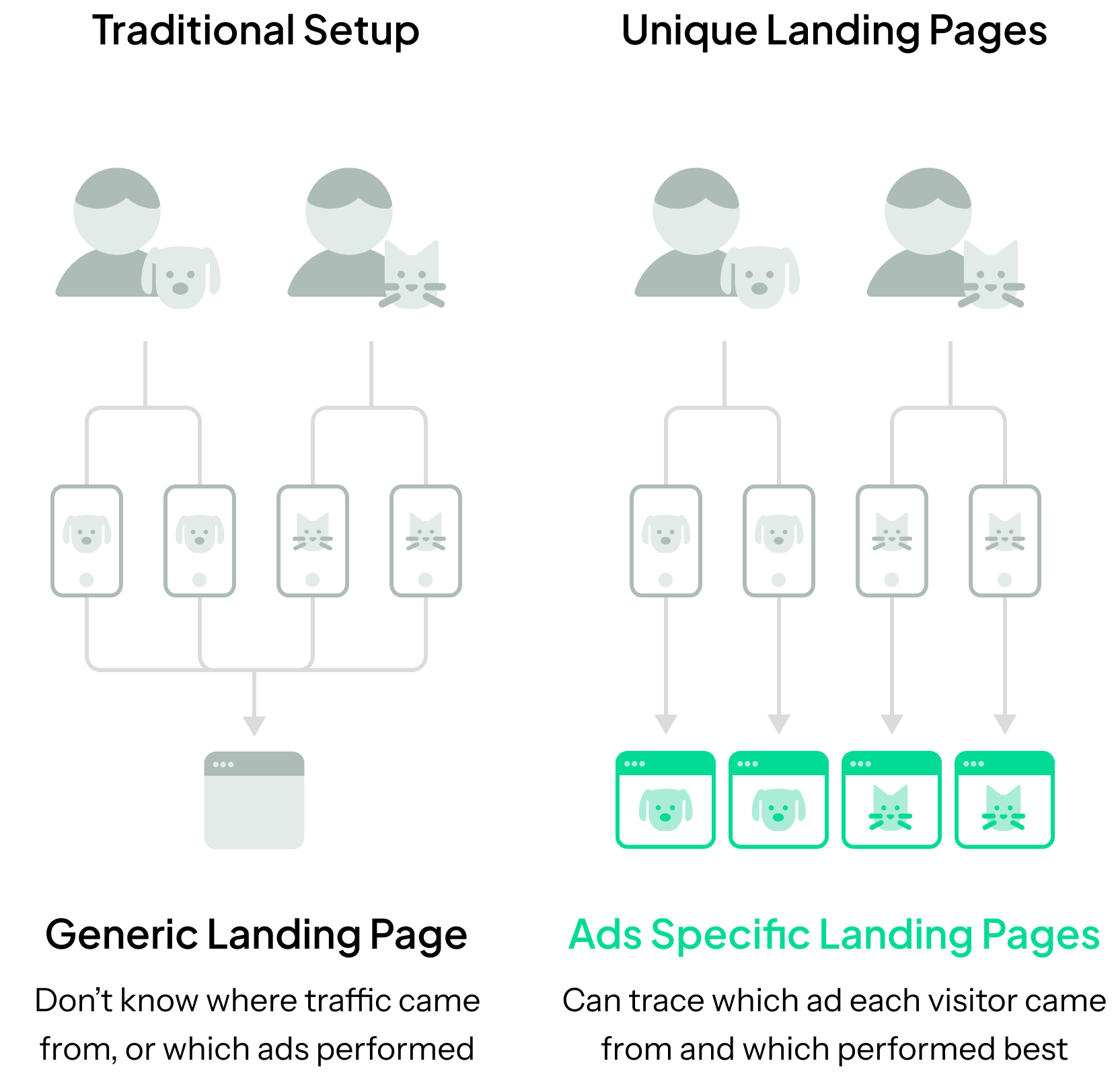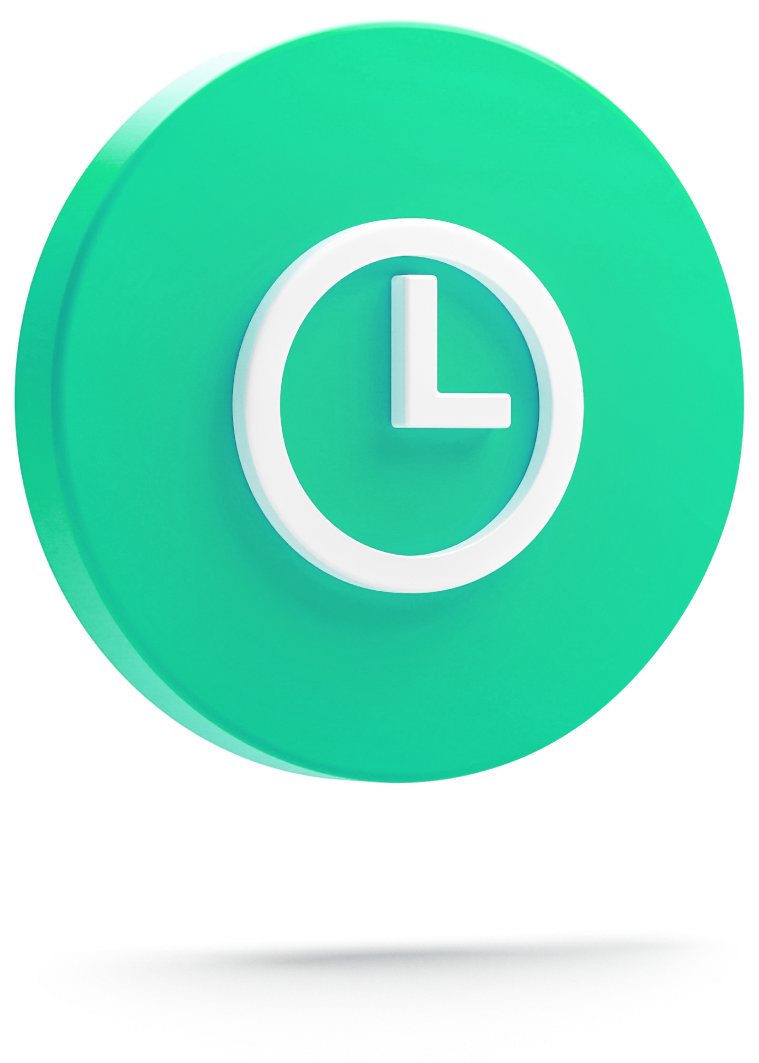Dáva Zmysel
[dah-va-zmee-zel] noun.
Dáva Zmysel: A unique and accurate SaaS solution for better tracking.

Accurate & Reliable
Tracking your marketing campaigns and understanding which ads, sources, or mediums drive conversions is harder than ever. Traditional tracking methods like UTMs, cookies, and pixels often fail to give you the complete picture, leaving you guessing about which strategies work and which don’t.
That's where Dáva Zmysel comes in — The SaaS solution designed to give you complete clarity into your campaigns and conversions.
Client Testimonials
“It makes sense.”

Monican Limanto
CEO & Co-Founder - Petsy
“It makes total sense.”

Tiaan Dreyer
CEO - Knose
“Yes, it really makes sense.”

Nathan Harris
CEO - The Pet Insurance Company
How Dáva Zmysel works
With Dáva Zmysel, you don’t need to overhaul your entire system or disrupt your current sales process. All you need to do is enquire about a custom solution for your specific quote tool, purchase path, or enquiry form, and we’ll handle the rest.
Here’s how we seamlessly integrate Dáva Zmysel into your existing workflows:
1. Integration into your current sales pages:
We work directly with your existing sales pages and lead generation workflows to create unique landing pages for each ad, source, and medium. This ensures that every visitor is attributed accurately to their original source, without interrupting your conversion process.
2. Seamless tracking, no disruptions:
Dáva Zmysel integrates into your system without affecting the user experience or sales journey. Visitors won’t even notice a change, but you’ll immediately start seeing the benefits—complete visibility into where every visitor comes from, and how they engage with your pages.
3. Enhanced conversion tracking:
Once integrated, Dáva Zmysel enables you to track which ads, sources, and mediums are driving the best results. You’ll see exactly how each campaign is performing—no more guessing or ambiguous direct traffic. With this level of insight, you can finally make data-driven decisions and optimise your marketing efforts.
From tracking to customisation: The power of data driven landing pages
After you’ve pinpointed which ads, sources, or mediums are driving the most conversions through Dáva Zmysel’s accurate tracking, you can take things one step further by creating fully customised landing pages.
Here’s what happens next:
1. Custom messaging for higher conversions:
Using the data from your tracking, you can create custom landing pages tailored to the exact ads or campaigns that drive traffic. For example, if you know that a certain Google ad is bringing in the most traffic, you can design a page with messaging, visuals, and offers that speak directly to that audience.
2. Source-specific customisation:
Not only can you personalise the message, but you can also customise the landing page based on the source or medium—whether that’s social media, email, or a specific ad. This leads to higher engagement and conversion rates because each visitor feels like they’re landing on a page designed just for them.
3. Increased conversion rates:
With unique and personalised landing pages tailored to the exact source, medium, and message, you’ll see a dramatic increase in conversion rates. The more relevant the page feels to the visitor’s journey, the more likely they are to convert.
Why choose Dáva Zmysel?
1. Accurate, real-time tracking:
Dáva Zmysel’s ability to create unique landing pages for each source and medium provides you with precise tracking. You’ll know exactly where each visitor came from, which campaign worked, and how they converted—without relying on error-prone UTMs or pixels.
2. Non-disruptive integration:
Unlike other solutions that require a complete overhaul of your sales process, Dáva Zmysel integrates smoothly into your current system. There’s no interruption in your purchase path or enquiry forms, and your customers will enjoy the same seamless experience.
3. Tailored for your business:
Whether you're running a quote tool, purchase path, or lead generation form, Dáva Zmysel can be customised to work for your specific needs. We’ll create a solution that aligns perfectly with your sales funnel and marketing goals.
4. Actionable insights for better campaigns:
The insights you gain from Dáva Zmysel’s tracking give you the power to make better marketing decisions. Once you know which ads or sources drive the best results, you can optimise your campaigns and increase ROI by focusing on what works.
Take control of your conversions
The era of incomplete tracking and “direct traffic” is over. With Dáva Zmysel, you can finally get the clarity and accuracy you need to take control of your marketing. No more guesswork, no more lost data—just clear insights that allow you to optimise your campaigns and drive more conversions.
And when you’re ready, we’ll help you take things further with customised landing pages that are tailored to your most successful ads, sources, and mediums. By offering a personalised experience to each visitor, you’ll increase conversions and get the most out of every marketing dollar.
What Does “Dáva Zmysel” Mean?
You might be wondering, how do you say Dáva Zmysel? Phonetically, it’s pronounced "DAH-vah ZMEE-sell".
The phrase comes from Slovak, inspired by one of our key developers, who was from Slovakia, where it means "makes sense"—and that’s exactly what we aim to do: help everything finally make sense in your marketing efforts. It brings clarity, understanding, and meaningful insights to the chaos of digital marketing.
The ultimate list of inferior tracking methods
What many are doing for tracking today here is a list of all the outdated an inferiority tracking methods that are either inefficient or unreliable in today's digital landscape:
1. UTM Parameters
Problem: While still used, UTM parameters often get stripped away or broken. They can also be blocked by privacy settings, browsers, or ad blockers, leaving you with incomplete data. Furthermore, managing UTM links at scale can be cumbersome and prone to human error.
2. Click Tags (Banner Ad Tracking)
Problem: Click tags were heavily used in older banner ads to track interactions. However, they're often inaccurate due to ad-blockers, or users may click by accident. The rise of programmatic advertising and more complex tracking methods have made click tags less relevant.
3. JavaScript-based Tracking
Problem: Relying solely on JavaScript can be problematic because many users disable JavaScript or use privacy tools that block it. Additionally, JavaScript trackers are slower to load and can lead to incomplete data if users navigate away from the page before the script is fully executed.

Comparing Dáva Zmysel (unique landing pages) vs traditional tracking methods
| Tracking Method | Advantages | Disadvantages | How Dáva Zmysel Solves This |
|---|---|---|---|
| UTM Parameters | Simple to implement. Works across multiple platforms. | Prone to being stripped by privacy settings, HTTPS/HTTP issues, or ad blockers. Human error in managing UTM links. | By creating unique landing pages for every source/medium, you don’t need to rely on UTMs that can be lost or stripped. |
| Click Tags | Quick tracking method for basic ads. | Easily blocked by ad blockers. Cannot capture user journey. No insights into conversion after the click. | A unique landing page ensures the full journey is tracked, not just the initial click, when added with first party IDs |
| Third-Party Cookies | Provides cross-site tracking for remarketing. | Increasingly blocked by browsers. Users distrust third-party cookies. Being phased out (e.g., Google). | First-party data through unique landing pages avoids reliance on third-party cookies. Stop relying on others |
| JavaScript Tracking | Can capture detailed user behaviour (scroll depth, clicks). | Blocked by some user privacy settings. Slower to load. May not trigger if the user exits the page quickly. | With a unique landing page, server-side events can still capture key actions, reducing dependency on client-side JavaScript. |
| Referrer Data | Provides basic info on where traffic comes from (previous site). | Often blocked by browsers. Lacks detail about specific ad campaigns. | Unique landing pages ensure that each visitor’s source is clear without relying on referrer data. |
| Pixel Tracking | Useful for tracking email opens or specific page views. | Increasingly blocked by email clients and browsers. Limited to knowing the visit happened, but not the full journey. | Full user journey is captured through unique landing pages, without relying on email or browser-based pixel tracking. |
| Server-Side Tracking | More reliable than client-side tracking. Bypasses browser restrictions and ad blockers. | More complex and costly to implement. Can lack granular user interactions (e.g., detailed behaviour). | A combination of server-side tracking + unique landing pages means more accuracy while keeping the setup relatively simple. |
| Session-Based Tracking | Helps understand user sessions in analytics. | Doesn't track users across devices. Limited insight into the source of traffic. | Each unique landing page is linked directly to a source or ad variation, enabling more detailed multi-device user tracking. |
| IP Address Tracking | Provides a rough idea of user location. | Unreliable, especially with VPNs or dynamic IPs. Cannot capture user behaviour. | Unique landing pages focus on user intent (via ads or sources) rather than IP-based tracking, making it more reliable and detailed. |
| Ad Impression Counting | Helps measure reach. | Does not indicate user engagement or actual clicks. Can lead to overvaluing ads with low engagement. | Each ad impression would be tied to a specific landing page, providing insight into engagement and conversion, not just views. |
| Form Submission Tracking | Clear metric for leads and conversions. | Misses the rest of the user's journey. Doesn't track non-converting visitors. | Unique landing pages allow tracking of the entire user journey, not just form completions. |
| Email Open Rate Tracking | Provides basic engagement data. | Blocked by privacy-focused email clients. Can be misleading due to automatic image loads. | Landing pages tied to specific email campaigns would allow you to track engagement beyond just open rates (e.g., clicks and actions). |
| Device-Based Targeting | Segments users by device for targeting. | Cannot track users across multiple devices. Often leads to incomplete data on user behaviour. | Unique landing pages can adapt based on the device and ensure more consistent tracking across sessions and devices. |
Tracking Method
Advantages
Disadvantages
How Dáva Zmysel Solves This
UTM Parameters
- Simple to implement.
- Works across multiple platforms.
- Prone to being stripped by privacy settings, HTTPS/HTTP issues, or ad blockers.
- Human error in managing UTM links.
- By creating unique landing pages for every source/medium, you don’t need to rely on UTMs that can be lost or stripped.
Click Tags
- Quick tracking method for basic ads.
- Easily blocked by ad blockers.
- Cannot capture user journey.
- No insights into conversion after the click.
- A unique landing page ensures the full journey is tracked, not just the initial click, when added with first party IDs
Third-Party Cookies
- Provides cross-site tracking for remarketing.
- Increasingly blocked by browsers.
- Users distrust third-party cookies.
- Being phased out (e.g., Google).
- First-party data through unique landing pages avoids reliance on third-party cookies. Stop relying on others
JavaScript Tracking
- Can capture detailed user behaviour (scroll depth, clicks).
- Blocked by some user privacy settings.
- Slower to load.
- May not trigger if the user exits the page quickly.
- With a unique landing page, server-side events can still capture key actions, reducing dependency on client-side JavaScript.
Referrer Data
- Provides basic info on where traffic comes from (previous site).
- Often blocked by browsers.
- Lacks detail about specific ad campaigns.
- Unique landing pages ensure that each visitor’s source is clear without relying on referrer data.
Pixel Tracking
- Useful for tracking email opens or specific page views.
- Increasingly blocked by email clients and browsers.
- Limited to knowing the visit happened, but not the full journey.
- Full user journey is captured through unique landing pages, without relying on email or browser-based pixel tracking.
Server-Side Tracking
- More reliable than client-side tracking.
- Bypasses browser restrictions and ad blockers.
- More complex and costly to implement.
- Can lack granular user interactions (e.g., detailed behaviour).
- A combination of server-side tracking + unique landing pages means more accuracy while keeping the setup relatively simple.
Session-Based Tracking
- Helps understand user sessions in analytics.
- Doesn't track users across devices.
- Limited insight into the source of traffic.
- Each unique landing page is linked directly to a source or ad variation, enabling more detailed multi-device user tracking.
IP Address Tracking
- Provides a rough idea of user location.
- Unreliable, especially with VPNs or dynamic IPs.
- Cannot capture user behaviour.
- Unique landing pages focus on user intent (via ads or sources) rather than IP-based tracking, making it more reliable and detailed.
Ad Impression Counting
- Helps measure reach.
- Does not indicate user engagement or actual clicks.
- Can lead to overvaluing ads with low engagement.
- Each ad impression would be tied to a specific landing page, providing insight into engagement and conversion, not just views.
Form Submission Tracking
- Clear metric for leads and conversions.
- Misses the rest of the user's journey.
- Doesn't track non-converting visitors.
- Unique landing pages allow tracking of the entire user journey, not just form completions.
Email Open Rate Tracking
- Provides basic engagement data.
- Blocked by privacy-focused email clients.
- Can be misleading due to automatic image loads.
- Landing pages tied to specific email campaigns would allow you to track engagement beyond just open rates (e.g., clicks and actions).
Device-Based Targeting
- Segments users by device for targeting.
- Cannot track users across multiple devices.
- Often leads to incomplete data on user behaviour.
- Unique landing pages can adapt based on the device and ensure more consistent tracking across sessions and devices.
Why Dáva Zmysel is a Good Idea
Precise Attribution
Every iteration of an ad or source/medium would have its own landing page. This means you can directly attribute conversions and user behaviour to the exact ad or campaign. No guesswork is required about which UTM parameters worked or what traffic source to attribute.
No Data Loss
Your idea works with first-party data through the use of your own domain's landing pages. This means it is less likely to be affected by privacy features that block third-party tracking, such as ad blockers, ITP (Safari’s Intelligent Tracking Prevention), or email privacy measures.
Enhanced Personalization
Each unique landing page can be tailored to the specific audience that came from a particular ad or source. This level of personalisation is much harder to achieve with generic tracking methods.
Better User Journey Tracking
With unique landing pages, you gain full insight into the user journey, from the first click to final conversion. This eliminates reliance on error-prone tracking methods like referrers, UTMs, or pixels.
Control and Flexibility
Because you control the landing pages and their content, you can A/B test, optimise, and adjust based on real data, not just assumptions from incomplete tracking.
Future-Proof
With third-party cookies on their way out and browsers increasingly blocking tracking, your approach is future-proof. It focuses on direct, first-party tracking through landing pages that aren’t dependent on the user's browser settings or privacy choices.
Example scenario
Let’s say you’re running a paid search campaign for pet insurance, targeting dog owners and cat owners separately.
In the traditional setup:
- Both campaigns might send users to the same general landing page for pet insurance.
- You’d have to rely on UTM parameters to figure out which visitors came from the dog vs. cat campaign, and hope the UTMs don’t get stripped along the way.
- If any of that data gets lost, you’re left with incomplete insights and visitors ending up in the direct traffic pool.
With unique landing pages:
- The dog insurance ad would send users to a landing page specifically for dog owners, with messaging, offers, and visuals tailored to their needs.
- The cat insurance ad would send users to a completely different page designed for cat owners.
- Each page would clearly show you exactly which ad and campaign brought the visitor, eliminating any tracking errors.

Now, when you review the results, you can confidently see that Landing Page A brought 50 leads from your dog insurance ad and Landing Page B brought 60 leads from your cat insurance ad. No ambiguity. No lost data.

How long would it take your dev team to make 20 pages?
By the time you’ve read this you could have already made:
115 pages
Effortless creation of unique landing pages—at scale
One of the key advantages of Dáva Zmysel is how simple and scalable it makes the creation of unique landing pages. Whether you're running dozens or hundreds of campaigns, you no longer have to worry about manually building separate landing pages for each one. Dáva Zmysel takes care of it for you—automatically.
How It Works: No-Fuss, Just Results
With Dáva Zmysel, you don’t need to be a web developer or spend hours tweaking settings. Creating unique landing pages is as easy as writing the URL you want—and that’s it!
Here’s how:
Enter Your URL:
Simply write the URL you want to use for a specific campaign, ad, or source. For example, if you’re running a Google Ads campaign for dog insurance, you might create a URL like yourdomain.com/ref/whatever-youwant
Magic Happens:
The moment you define that URL, Dáva Zmysel automatically generates a fully functional unique landing page designed for that campaign. No coding, no complex integrations—just instant results.
Scale without the headaches
Running multiple campaigns across different channels can get overwhelming—especially when you’re trying to track and optimise performance. But with Dáva Zmysel, you can scale your efforts without the stress:
- Unlimited Unique Pages: Whether you need 10 or 10,000 landing pages, Dáva Zmysel generates them at scale, effortlessly. You’ll never need to manually create or manage separate pages again.
- Instant Creation: The moment you define a URL, the landing page is ready to go—instantly. This allows you to rapidly deploy new campaigns without any delays or extra work.
- Total Control: Want to update your page messaging? Make changes at any time—across multiple landing pages—without interrupting your workflow.
A true no-fuss application
What makes Dáva Zmysel stand out is how simple it is. It’s a no-fuss application that fits seamlessly into your current marketing setup:
- No manual page creation required.
- No complex tools to learn or manage.
- No disruption to your existing workflows.
All you need to do is specify the URL you want, and the page will appear—ready to track your traffic and convert visitors. It’s truly that simple.
Take the hassle out of landing pages
Stop worrying about the technical headaches of managing landing pages for every campaign. With Dáva Zmysel, you can create fully customised landing pages at scale, with just the click of a button. Whether you’re running ads on Facebook, Google, email, or social media, your pages will be ready, tailored, and optimised for conversions.
Book a Demo
Submit your email below and one our product experts will be in touch to schedule a time for your personalised 30 minute walk through, specified to your business case.
Contact Us
We will get back to you as soon as possible.
Please try again later.
CONTACT
+61 2 8313 0403
dingdong@davazmysel.com
Suite 58, 388 George Street, Sydney NSW 2000
a Who Do Do Pty Ltd Brand